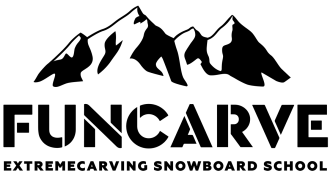Elements. Basic body position
Very much depends on how exactly the snowboarder is placed on the board. The location of the centre of gravity and the part of the foot that takes more weight has great importance. Seemingly minor aspects of basic position influence all these things.
The purpose of basic position
The main purpose of the basic position is maximum load of the length of the edge for sure cohesion between the snowboard and the slope at any speeds.
The basic position
Stand upright with your weight distributed evenly on both legs 50:50 and along the feet. Knees slightly bent, back straight, shoulders back, arms placed freely on hips, chin is looking ahead. Relax, enjoy yourself in balance and comfort. Remember this feeling.
By bending slightly both of your knees you will be able to rotate them smoothly forward to the nose of the board, check the weight distribution 50:50 between your legs. You should rotate your hips by the angle your bindings have. Ideally the parallelism of bindings’ axes should be the same as the parallelism of axes of knees and hips. You likely ask for what?
Exactly those who don’t control the position of their hips have the syndrome of "sticked out butt" Slightly lift your hands from the hips and leave them palms down. Remember the feeling of comfort and balance. If you cannot do it then start over. The problem may be in bindings’ settings, too large or too small distance between them or the angles that you have chosen.
Typical mistakes
- You look down.
Trying to look at something under their feet people bend their back reflexively, push shoulders forward and pelvis back, besides at the same time they shift the centre of gravity forward along their feet, closer to the toes. - Bending forward on the backside.
Beginners often use angle in the hip joint to create edging of the board on the backside what isn’t always right. This is called angulation but usually beginners do it in a wrong manner and to one side only. They edge the board on frontside with help of inclination. Knees bent strongly, back hunched, hands hanging down – all these are mistakes interrelated reflexively and often complementary. They also cause imbalances and falls; - Twisting the body too much to one of the sides.
Again people shift reflexively their weight to the leg to which the body is twisted and hence the longitudinal weight distribution of 50:50 is broken. This leads to the loss of control over the board due to overload/ underload of the nose/ tail of the board in the turn. - Starting backside turn with your hip.
When the turn of your hips isn’t sufficient the body starts the turn with the hip, not with the knee. And the Syndrome (of sticked out butt) appears due to the influence of centripetal and centrifugal forces. You should focus on starting the turn with your knee. You should bend it forward and turn it so that it falls within your field of view (but don’t forget about 50:50). The turn of your back knee according to the direction of your movement also helps but you should prevent its sticking to the front one (old school technique "knee-to-knee ")



